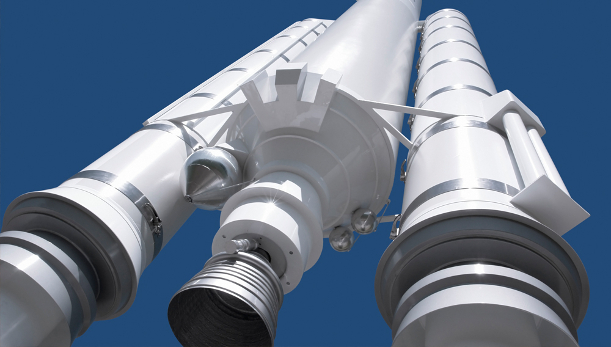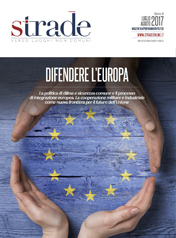Space policies, economic internationalization and EU integration
Luglio/agosto 2017 / Monografica
Satellite constellations are a strategic infrastructure essential for both military and civilian purposes. European space programs such as Copernicus and Galileo are not only a success of the European Union, but also contribute, in a tangible way, to strengthen integration policies. And support for space economy is crucial for the establishment of new businesses and the technological innovation of society.

Last December I was in Brussels for the declaration of Galileo Initial Services, the constellation of satellites for navigation and global positioning of the European Commission, carried out by ESA (European Space Agency). It was a very important moment for Europe: all those who were present clearly perceived the strategic and symbolic value of that day, which marked the passage of the global satellite navigation system from the test stage to that of the first operational services.
If for the first time European satellites started to provide users with position, navigation and time information on a global scale, from a symbolic viewpoint, public opinion does not clearly understand the enormous political value of that day: the will to be equipped with Galileo is the result of a global projection of Europe, which thanks to this service will be present all over the world. In a moment of objective difficulty, where the correct observations on the lack of cohesion of the European Union overlap with the simplistic recipes to end a path – it’s a good idea to remember it – that started sixty years ago with the Treaties of Rome; Europe with Galileo begins again to “fly high” and to speak with one voice, that of a service accessible to everyone and at any latitude.
Pointing out that European space programs are not only a project and technological success of the Union, but they contribute in a tangible way to reinforce integration policies, means to recognize today that political action that began sixty years ago, brought results that exceeded the expectations of that historical moment. In 1957, indeed, no space policies were considered, which would then become the competence of the European Union only with the ratification of the Treaty of Lisbon.
This leads us to a thought: The founding fathers of Europe, who with the democratic consent of their countries undertook this path, were political men aware of the challenges, the risks and the needs to face them together; they were pragmatic political men, who acted under an ideal drive. It is exactly what is done in the European space, a priority and an essential element for its own sovereignty. Satellite constellations are an essential strategic infrastructure: from telecommunications to navigation, from climatic and production monitoring to mining or agriculture applications, satellite infrastructure is a primary tool of the contemporary political and economic world.
Copernicus and Galileo, the two European Space programs created by ESA, are therefore strategic assets since space marks and will mark more and more the time of social and economic life. That is why it is important to promote and maximize the use of available space data and at the same time to consider the development of these programs in order to ensure that all European citizens may access the benefits arising from these important investments. Therefore, it is necessary a holistic approach to space as a “system of systems”, whose components can be based on the integration of different systems, technologies and services, both traditional “terrestrial” and typical of space programs. In this framework, the services and applications arising from Earth observation is destined to grow, creating an extraordinary new value chain capable to reach all institutional and commercial users, as well as private citizens.
For this reason, the Conclusions of the Competitiveness Council on space held on May 30, concerning a new space strategy for Europe and strongly wished during the Italian Presidency in 2014, are very important. A strategy showing a commitment to maximize the economic and social benefits of space, increasing the use of space technologies and applications to support public policies, in order to strengthen a competitive and innovative European space sector at the global level.
It is an ambitious strategy that as such shall be accompanied by an equally ambitious financial plan for the next years. A space budget that can guarantee, inter alia: the development of the downstream market, closely linked to the continuation of Galileo and Copernicus; the consolidation of autonomous, reliable and sustainable access to space through the use of Vega-C and Ariane 6 European launchers; continuous research and innovation activity, especially regarding technologies; the transformation of initiatives such as those related to Space Surveillance and Tracing (SST), to protect European infrastructures from space debris, into real EU programs with a dedicated budget; and, last but not least, the launch of new initiatives such as Govsatcom, to ensure secure, efficient and cost-effective communication services for all European institutional players.
As also planned in the new national space strategy – which was already successfully launched in Italy, entrusting ASI with the role of system architect – support for space economy is crucial for the establishment of new companies, start-ups and small and medium-sized companies. To do this we need to facilitate access to risk capital and make available new financial instruments. The aim is to turn the European space industry into one of the driving engines of growth.
We need to ensure that services arising from spatial applications and technologies are not brokered by companies located on the other side of the Atlantic or Asia, but by companies located in Europe and possibly in Italy, because the vast economic and social transformations, such as those triggered by the Internet and space applications, if they do not see the participation of European economic and industrial players, are exposed to risk to end up affecting all Union citizens.
The approach of the political decision-maker to the space sector, therefore, must not only have the purpose of making public intervention more efficient but of placing it on a different position: the engine and the integrator of technological innovation processes in society. Thus, as already happened in the past, when the “space race” was funded by governments primarily for strategic military reasons, today the new space economy, started in the United States, is the result of large public investments that allowed the growth of innovative companies.
Europe’s reply heads in the right direction: the European Union to achieve the objectives identified in its strategy will need the support of all European space players that shall, as they have done until now, work with well-defined roles in a synergistic manner to prevent duplication and overlapping.
The Conclusions of the Competitiveness Council remind us of the fundamental actions to complete this project: a) strengthening Europe’s independence in critical technologies and space systems; (b) ensuring long-term European public support measures; (c) promoting a competitive and sustainable supply chain; (d) facilitating access to export markets while ensuring equal conditions for the European operators; (e) intensifying efforts to eliminate internal technical and regulatory barriers at national and EU level; (f) facilitating access to risk capital and smart funding; (g) supporting innovation and the development of space applications, commercial opportunities, awareness-raising and industrial capacity, even for the companies and initiatives for New Space, SMEs, start-ups and scale-ups.
In this regard, I would like to remember with pride the case of AVIO, the world first launcher company quoted on the stock market, a success of Italian space economy. It was above all a satisfaction for the excellent system work that, starting from the commitment of the Italian Space Agency in the context of two ESA ministerial decrees (2014 and 2016), saw a consistent action by AVIO management and shareholders, and showed that Italy, when it wants to make system, is able to reach important targets. It was a success in a high-tech strategic sector where the State guaranteed the necessary investment funds in a long-term project that required a typical strategic approach to public financing agencies.
We can say that the Italian Space Agency was the “business angel” of this operation: the decisions of the two ESA ministerial decrees saw the joint Italian-French financing for the development of Vega-C. In 2014, the Italian investment in ESA gave AVIO and its industrial chain € 256 million for the development of the new P120 engine, the common engines of VEGA and Ariane launchers that will be produced at a rate of 35 units a year. This money was well spent, because it allowed the growth of an Italian company and made it competitive in a European context to allow it to enter the stock market. A story of Italian industrial success in Europe as we would like to see many others.
In conclusion, space is a great opportunity because it well represents the complexity of our time and at the same time gives us, in addition to interesting indications, even the inspiration to dominate this complexity, full of contradictions, difficulties, but also of promises. It is the top view that helps man in understanding and overcoming contradictions. Whether they are astronauts or satellites, space is the “infrastructure of infrastructures” that from the top can better make us understand, organize and coordinate the complex and interconnected world where we live.
INDICE Luglio/agosto 2017
Editoriale
Monografica
- Europa della difesa? Costa meno e ci rende più sicuri
- Investire in sicurezza: il fondo Ue per la difesa
- Common defence and security, the return of politics
- Defence as a currency, a European sovereignty
- Europe, time to unite forces
- Difesa e sicurezza comune, la rivincita della politica
- A possible EU army under current treaties
- La difesa come la moneta, una sovranità europea
- What defence for what Europe?
- Europa, è il momento di unire le forze
- Space policies, economic internationalization and EU integration
- Un esercito comune e comunitario. L’europeizzazione possibile a trattati vigenti
- A United Europe for Defence? Increased safety and lower costs
- Quale difesa per quale Europa?
- Investing in security: the European Fund for Defence
- Le politiche spaziali, l’internazionalizzazione e l’integrazione dell’Ue









